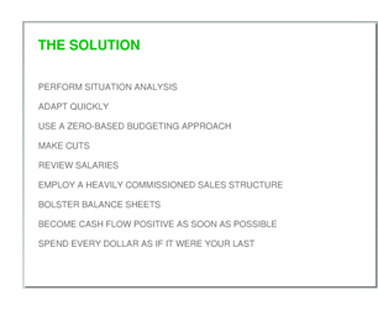 There are two sides to every story, and two unenviable roles to a firing. While I don’t expect newly aroused sympathies to change anything, awareness of each other’s perspective can help make the process a little less painful. That is, if you believe yanking off a band-aid is less painful than pulling it off slowly . . .
There are two sides to every story, and two unenviable roles to a firing. While I don’t expect newly aroused sympathies to change anything, awareness of each other’s perspective can help make the process a little less painful. That is, if you believe yanking off a band-aid is less painful than pulling it off slowly . . .
Cutting expenses is one thing — delaying purchases, ditching the PR agency (God, they hate being the first to go), abolishing free soft drinks (really?). But cutting people is, well, personal. Leader truly get their mettle tested in the process. But since it’s not something managers do that often, I guess it shouldn’t be surprising how badly most of them handle it. Email? Over the weekend? Like the pink-slips of old, big-company cowardly. Bad form.
Notes for the ‘choppers’
All you managers under pressure –though I don’t expect arrogant CEOs to read this, much less heed the points — it’s time to act, or be acted upon. Look on the bright side: a headcount reduction gives you the opportunity to reshape the organization. Let’s face it, not everyone you hired ended up exceeding expectations. Even if the hiring process included a probationary period (it always should) to admit a mistake was made, during a RIF you get to lop off anyone close to the line.
Encourage yourselves with the conviction that the organization will be better, leaner, and more dedicated than ever before. Just remember that the folks you want to stick around will judge very carefully how you handle the process.
Some observations and considerations (nothing comprehensive) for you unenviable leaders:
1. Once the decision is made, move swiftly.
Bring all your appropriate managers into the process — they’ll surely have something to contribute. Then meet with them 1:1, provide them a directive (e.g., 20% cut), and let them own the decision for their people. Complete this process all on one night, off site — no closed doors, which only feed the rumor mill.
2. HR (if you have one) may or may not know best, but should be completely involved.
The HR managers that I hired for recruiting skills turned out not always to be the best HR administrators; nonetheless, they are employee advocates, and should be your sounding board. If you’re big enough to have hired an experienced HR person, they will have the forms and know the laws. On the other hand, if you’re a startup taking 20 people going down to 15, you probably won’t (shouldn’t) have an HR person. I’ve used PEOs (Professional Employer Organizations) such as TriNet (which make business sense up to a couple dozen employees, beyond which the fees dictate you wean yourself of them), and when we went through our Bubble 1.0 layoff (40%), they knew their stuff — had done quite a few, in fact. Helped us think of everything.
3. All the packages and details for outgoing employees should be complete before the button is pushed.
Prewire everything. Most of all, your IT guy/gal (if they’re on the hit list, you’d better solve that problem first). All the letters (I’ve found that including recommendation letters in the package buys a lot with people), instructions (such as the consequences of their stock options), copies of the Confidentiality Agreement that they signed at hiring, etc., should be bundled together. I’ve learned to lean towards trusting people to behave (although it hasn’t worked out 100% of the time), so I wouldn’t immediately cut off email, or block access to their computer. Big companies will always do this; if you’ve managed your startup well, with full transparency, there shouldn’t be a need. Sales and marketing people will often want to send out an email blast to customers and contacts; let them. Blocking them will only result in them doing it from their personal email. But passwords to Salesforce.com, VPNs, etc. need to be covered. Provide your managers with a comprehensive checklist for each employee.
 4. Execute as simultaneously as possible — and with military precision.
4. Execute as simultaneously as possible — and with military precision.
This was impossible during my first big layoff, when we went from 175 to 125 (not to mention things were so out of hand, my finance director — who obviously did not expect to be terminated — ran around the building, screaming epithets, while I chased after him . . . swear to God), but for most situations it can be done, late afternoon, at most in two or three passes per manager. Have two people in the room, if you can. Everyone’s rehearsed, the package is delivered, and the whole thing takes two minutes. Remote workers will have to be done by phone (not email). Don’t expect anyone to sign anything on the spot — just collect keys, passes, etc., and don’t shame them by making them clean out their desks in front of others. Let them come back. Treat them with dignity.
5. Don’t drop another shoe
Make your cut deep enough to last. And when it’s done, gather everyone together and have a state-of-the-company address. Tell everyone what the runway looks like from here. Make them comfortable that you won’t be nicking away at things over the next few months, which only leaves everyone paranoid.
I expect there are more and more of you out there coming up on a crappy experience like this. (For more good reading on the topic, go here.) But there’s a happy ending. When it’s over, you’ve done your job (as described by Sequoia, at right), and you’ve done the very best you can for the outgoing — and bonded with the keepers — you not only attain a pride of passage, but things get better very quickly.
Notes for the ‘choppees’
Now, let’s take the other perspective. Some of you are going to be on the receiving end. And most of you — who thought everything was cool a couple of weeks ago — will be stunned to hear it. (Things probably were cool.) But the pressure from investors, coupled with genuine fear about the marketplace, has instilled a new mindset in your leaders: survival.
Some observations and considerations (nothing comprehensive . . . and this is not to be construed as legal or even professional advice) for you who are about to find the axe befall you:
1. Don’t flip out
Yeah, never thought you’d be on the list. Neither did I. But the highly charged moment of termination, when your stomach is knotted and blood is rushing to your head, is not the time to seek answers (much less revenge). Cooperate. No, I wouldn’t sign anything — there’s no reason why you shouldn’t have a day or two to read everything. Just know that, in the end, the company has the leverage — in your paycheck, severance, stock, and references/recommendations. If you really feel you’ve been wronged, get a lawyer.
2. Don’t expect much
Leaving the corporate world for the startup world, you said goodbye to lots of resources and perks. When I was fired from my corporate job (by a back-stabbing son-of-a-bitch bastard who needed my P&L because his was dying and oh, yeah, I didn’t see that one coming), I got nine months’ severance, outplacement services, and a glowing recommendation letter. When the VCs pulled the plug on a startup I joined as Senior Vice President of Marketing, I got two week’s pay. (I appealed to the CEO — who was obviously on the way out himself — and they upped it to three weeks.) In startups, you hope for two-weeks pay. (It’s all about conserving cash, remember?)
3. Center yourself
Go for a run, or take it out in the gym. There’s anger that needs to be processed, and you need to move past that to get to the next stage: excitement about what you’re going to do next. What make things especially hard for people in startups is that your world is pretty much tied up in your work. Sure, you have loved ones, but on an hours-per-day basis, when the company you worked for — the thing you were so passionate about being part of and helping build — suddenly goes away, that’s a big hole in your life. Take advantage of it. Indulge your family or loved one with some time. Plot your next moves. Maybe, start something yourself.
4. Move on quickly
You know what they say about a broken heart — nothing cures it like something sweet and new coming along. The sooner you get on with your life, the better. Spend as little time looking back as your mind will allow. The remarkable thing is, nine out of 10 times, people say (maybe not Stuart Sutcliffe) that life got better after leaving the organization. Whether or not you subscribe to the ‘everything happens for a reason’ theory, everyone I’ve crossed paths with who’s been through the shock of getting fired — even at my hand — ended up with no regrets.
There’s a lot of nuances I’m skipping over, some are location-specific, some company-specific.
Whereas California has nixed non-competes, they’re alive and well on the East Coast . . . and they suck. Companies may hold stock grants and severances (by law, they can’t withhold back pay owed) hostage to get non-competes signed, and they’re usually at least a year, sometimes longer. Ridiculous.
Then there’s your vested stock options. These conditions can be all over the map — now might be a good time to reread your Stock Plan and Stock Option Agreement. Is the company entitled to repurchase your vested shares? (I hope not). At what price? If not, you may have only 30 days to purchase them yourself. But again, at what price? The recent Fair Market Value may not reflect the economic crash . . . and you might find yourself having to write a check for several hundred (or thousand) dollars, or forfeit the ownership.
Just a heads up. But hey, things could be fine. Just because a half-dozen startups have already had major layoffs, doesn’t mean yours is about to . . .
Forewarned is forearmed.
